Volunteer Fire Fighter Dies in a Single-Motor-Vehicle Crash While Responding to a Medical Assistance Call – Louisiana
 Death in the Line of Duty…A summary of a NIOSH fire fighter fatality investigation
Death in the Line of Duty…A summary of a NIOSH fire fighter fatality investigation
F2011-21 Date Released: October 5, 2012
Executive Summary
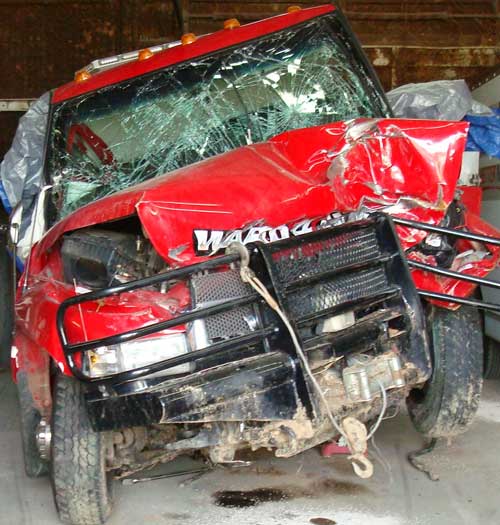
On September 3, 2011, a 22-year-old male volunteer fire fighter (the Victim) was fatally injured when the fire department service truck (S1), he was driving en-route to a medical assistance call crashed. The Victim was traveling alone on a narrow, unmarked, asphalt road that had a bend to the right at the bottom of a slight grade. While attempting to negotiate the bend, the Victim lost control of the truck which was equipped with a slip-on unita, ran off the left side of the roadway and landed in a ditch embankment against a tree. The slip-on unit detached from the truck bed and landed near the front of the truck. Fire department personnel arrived quickly on the scene and began preparing the truck to remove the Victim who was alert and communicating. However, once extricated and transported to a local hospital he succumbed to his injuries.
aA slip-on firefighting unit consists of a water storage tank, an auxiliary engine-driven centrifugal pump, a hose reel, and a control panel. It is designed to be placed on a truck chassis or trailer.
Contributing Factors
- Speed
- Narrow, unmarked, rural roadway
- Rain and poor visibility.
Key Recommendations
- Develop, implement, and enforce written standard operating procedures for all operations
- Ensure that all fire service vehicles are operated safely taking into consideration road and weather conditions, and in accordance with department emergency response protocols
- Ensure that vehicle/apparatus maintenance programs comply with applicable National Fire Protection Association (NFPA) standards and that all maintenance and repairs are performed by qualified technicians
- Provide initial and refresher training to all drivers on each vehicle they may be called upon to operate
- Ensure that seatbelts are properly worn at all times by drivers and occupants of all department vehicles
- Ensure that all vehicle modifications are completed by a qualified source and are designed and installed within the manufacturer’s specifications and NFPA guidelines
- Be aware of programs that provide assistance in obtaining alternative funding, such as grant funding, to replace or purchase fire apparatus and equipment.
Introduction
On September 3, 2011, a 22-year-old male volunteer fire fighter (the Victim) was fatally injured when the fire department service truck he was driving crashed as he was en-route to a medical assistance call. The Victim was the only occupant of the truck. On September 6, 2011, the U.S. Fire Administration (USFA) notified the National Institute for Occupational Safety and Health (NIOSH) of this fatality. At the department’s request, the investigation was delayed until October 4, 2011, when an Occupational Safety and Health Specialist from the NIOSH Fire Fighter Fatality Investigation and Prevention Program traveled to Louisiana to investigate the incident.
The NIOSH investigator met with and interviewed persons from the fire department who were on the scene shortly after the crash and who assisted in extricating the Victim from the wreckage. Fire department representatives accompanied the NIOSH investigator to view and photograph the slip-on unit, the scene of the crash, and the involved fire apparatus which was being held at a towing/impound facility. The NIOSH investigator also contacted a slip-on unit manufacturer and information on the truck was obtained through the VIN (vehicle identification number). The NIOSH investigator reviewed the department’s vehicle maintenance records for the truck involved in the crash, dispatch records of the incident, witness statements, the victim’s training records, and police reports and photographs of the incident scene.
Fire Department
The volunteer department involved in this incident has one fire station serving a primary rural response area of 570 square miles. A total of 19 volunteer members serve about 15,000 residents responding to approximately 20-30 emergency incidents per year.
The department had one engine, one ladder truck, and a service truck (S1) which was the incident vehicle, housed at the station where the Victim was based. At the time of the investigation, the department did not have written standard operating procedures (SOPs) regarding the operation of vehicles or driver training.
Training and Experience
The Victim had been a fire fighter for more than three years and had been with the same department for the entire time. He had successfully completed training in many courses including Fire Fighter I and II, pump operations, fire fighter safety at highway scenes, fireground rescue, self-contained breathing apparatus, and first responder. In 2009 the Victim had completed a 12-hour Driver-Operator course, and in 2010 he completed a 4-hour course on operating emergency vehicles conducted by a local university’s fire and emergency training institute personnel. Members receive training conducted by department personnel in-house or through the fire and emergency training institute affiliated with a state university. The degree of practical hands-on training could not be determined.
Equipment and Personnel
The incident involved a department multi-use service truck that was equipped with a slip-on unit, also known as a slip-on water tank unit or skid unit (see Photo 1). The slip-on unit was equipped with a 150 gallon baffled composite tank that was full at the time of the crash. There is no evidence to suggest there was a safety issue with the installation of the slip-on unit, however, it detached from the truck bed upon initial frontal impact with the ditch, and landed in the underbrush near the front of the cab.
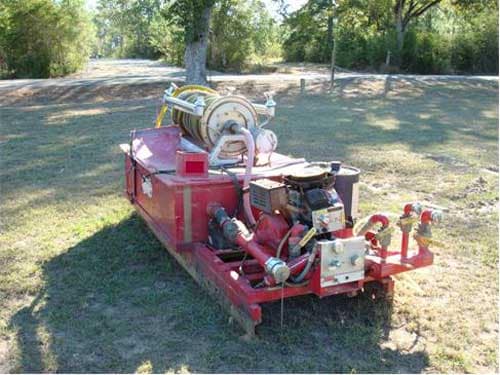
Photo 1. Photo shows the slip-on unit involved in the incident.
(NIOSH Photo)
The truck was a 1998 rear-wheel drive model with a gross vehicle weight rating (GVWR) of 10,500 pounds and it measured 220″ in overall length and 93″ wide with a 134″ wheelbase. The bed of the truck was 97.5″ long and 64″ wide. The department had modified the truck to transport a slip-on-unit. There is no evidence that total weight of the truck, occupants, slip-on unit, and equipment exceeded the GVWR. The driver and officer seat positions were both equipped with three-point adjustable seat belts and airbags. Witness statements conflicted as to whether or not the victim was wearing a seat belt at the time of the crash. He had driven the truck prior to the incident and was the driver and sole occupant at the time of the crash.
Timeline
The timeline for this incident details all activities pertaining to the vehicle crash.
- 1508 Hours
The Parish Sheriff’s Office dispatch received a request for an ambulance to respond to a private residence for a medical emergency. - 1515 Hours
Department service truck (S1) was dispatched to the medical assistance call per department procedure. - 1521 Hours
A motor vehicle crash involving a fire department vehicle was called into dispatch, advanced life support ambulance dispatched and en-route. - 1524 Hours
Ambulance arrived on the scene. - 1610 Hours
Ambulance departed crash scene en-route to the hospital. - 1620 Hours
Ambulance arrived at the hospital. - 1759 Hours
The Victim was pronounced dead.
Weather and Road Conditions
Tropical storm Lee was approaching inland Louisiana on the day of the incident. The area had received approximately ½ inch of rain and it was raining at the time of the incident. The temperature was approximately 75°F with a 10 mile per hour (MPH) sustained northerly wind gusting up to 23 MPH.1 The weather is a possible contributory factor in this incident because of the resulting poor visibility and wet road surface. The crash occurred on a rural, two-lane asphalt roadway measuring 20′ in width. It was bordered by narrow grass and dirt shoulders that had intermittent drop-offs (see Photo 2). The road travels north to south with an east to west bend near the area of the crash. There was no posted speed limit in the area and the roadway had no perimeter markings, center dividing lines, guard rails, or curve warning signs.
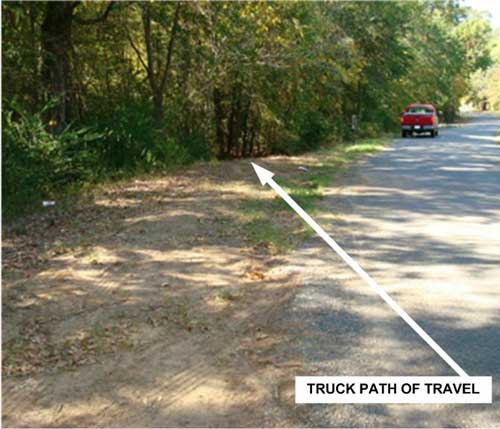
Photo 2. Photo shows the roadway and location where truck exited.
(NIOSH Photo)
Investigation
At 1508 hours on September 3, 2011, the department was dispatched to a medical emergency call. The Victim responded from the station driving the service truck and according to witness statements, the emergency lights were activated. By the time the Victim departed the station, there were emergency response personnel at the scene of the medical call and an ambulance was enroute. It was raining at the time and visibility was limited. The route to the medical call was a north /south two-lane asphalt roadway that was bordered by narrow grass and dirt shoulders with intermittent drop-offs. The Victim was travelling south where the roadway was elevated passing over a drainage ditch before entering into a bend to the right. According to the police report, the Louisiana State Patrol estimated the speed of the truck at 50 MPH as it approached the bend in the road, which officers determined was too fast for the truck to negotiate the bend safely.
According to the police report, skid and tire marks were located on the pavement and off the east side of the roadway. The markings indicated that as S1 was about to enter the bend, the Victim applied the brakes and travelled approximately 70′ before leaving the roadway. Upon exiting the roadway, S1 continued forward movement and travelled an additional 50′, then vaulted approximately 37′ striking a dirt embankment in the drainage ditch before coming to a final stop approximately 40′ to the east side of the road with the cab crashed into a tree (see Diagram 1 and Photo 3, Photo 4, and Photo 5). The slip-on unit detached from the truck bed upon initial frontal impact with the ditch, and landed in the underbrush near the front of the cab. Witness statements conflicted as to whether or not the victim was wearing a seat belt at the time of the crash.
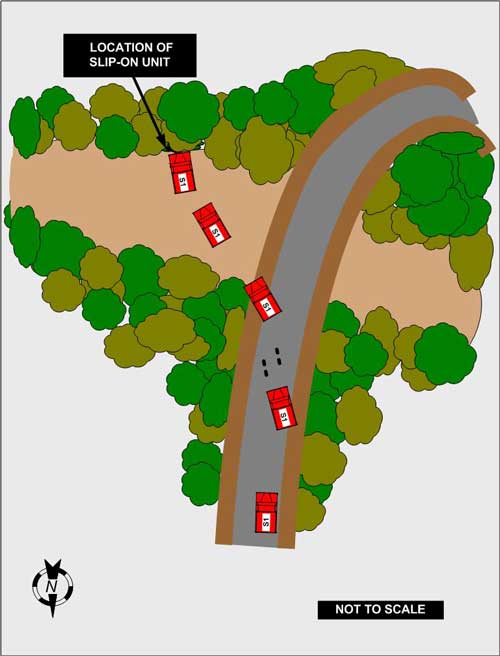
Diagram 1. Diagram depicts an overview of the incident scene.
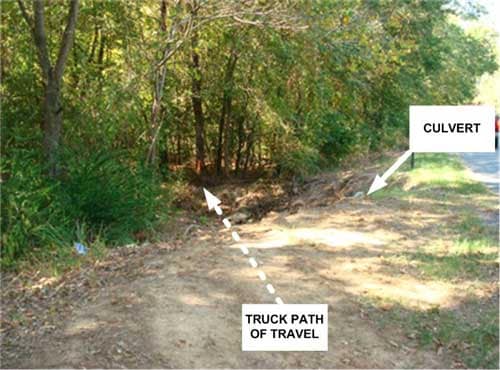
Photo 3. Photo shows location of the truck’s path of travel.
(NIOSH Photo)
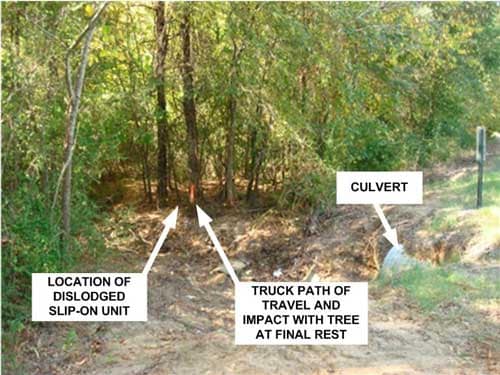
Photo 4. Photo shows location where truck impacted the tree.
(NIOSH Photo)
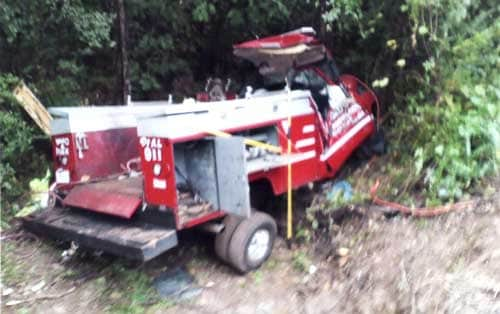
Photo 5. Photo shows the final location of the truck.
(Photo courtesy of fire department.)
Fire fighters were near the crash scene attending to the initial medical emergency call when they received notice that a passer-by had called the crash into the 911 dispatch center. The call came in at 1521 hours. Several fire fighters responded immediately to the incident scene and began extrication procedures. An advanced life support ambulance was dispatched to the scene and arrived at 1524 hours. Medical helicopters could not fly due to rain and wind from the approaching tropical storm. The victim was extricated from the wreckage, evaluated, immobilized and prepared for transport. He remained alert and communicated during the extrication procedure and while being transported to a local hospital. Unfortunately, he succumbed to his injuries at 1759 hours while in the hospital.
Contributing Factors
Occupational injuries and fatalities are often the result of one or more contributing factors or key events in a larger sequence of events that result in the injury or fatality. NIOSH investigators identified the following items as key contributing factors in this incident:
- Speed
- Narrow, unmarked, rural roadway
- Rain and poor visibility.
Cause of Death
According to the death certificate, the Victim died from multiple blunt force trauma.
Recommendations
Recommendation #1: Fire departments should develop, implement, and enforce written standard operating procedures for all operations.
Discussion: NFPA 1500 Standard on Fire Department Occupational Safety and Health Program 4.1.2 states that, “the fire department shall prepare and maintain written policies and standard operating procedures that document the organization structure, membership roles and responsibilities, expected functions, and training requirements, including the following.
- The types of standard evolutions that are expected to be performed and the evolutions that must be performed simultaneously or in sequence for different types of situations
- The minimum number of members who are required to perform each function or evolution and the manner in which the function is to be performed
- The number and types of apparatus and the number of personnel that will be dispatched to different types of incidents
- The procedures that will be employed to initiate and manage operations at the scene of an emergency incident.2
Unwritten directives are difficult to learn, remember, and apply. Fire departments should develop SOPs for all operations and these operational procedures should be committed to writing. Each fire fighter should have a written copy of the SOPs and they should be the subject of department drills and training. Developing the SOPs is the responsibility of department administration, but it is recommended that members from all levels of the department be involved in the development, periodic review and revisions when necessary. Examples of the topics that should be included in department SOPs include:
- Minimum training requirements
- Vehicle inspection and maintenance procedures
- Emergency and non-emergency operations
- Command responsibilities and procedures
Developing and maintaining SOPs is only part of the equation. If the department fails to educate the members on the procedures and then also fails to consistently enforce them, the best SOPs ever created are worthless. Departments must hold members accountable for following the SOPs. Lacking accountability, SOP’s often get disregarded which leads to unsafe behaviors, unnecessary property damage, injuries, and deaths.3
The International Association of Fire Chiefs (IAFC) has developed policies and procedures for emergency vehicle safety. According to the IAFC, many vehicle crashes could be prevented through the proper implementation and application of SOPs. Their guidance document “Guide to IAFC Model Policies and Procedures for Emergency Vehicle Safety” can be used as a resource by fire departments for developing their own departmental SOPs.3 Other resources have been developed by the National Volunteer Fire Council (NVFC) “Emergency Vehicle Safe Operations for Volunteer and Small Combination Emergency Service Organizations,” 4 the U.S. Fire Administration’s “Emergency Vehicle Safety Initiative,”5 the Emergency Responser Safety Institute training programs (ERSI),6 and VFIS.7
Additionally, as stated in NFPA 1250 Recommended Practice in Emergency Service Organization Risk Management, Section 4.2.1, “The fire emergency services organization should have a written policy statement that clearly reflects its commitment to risk management through the development, implementation, and administration of a risk management program.”8
The fire department involved in this incident did not have written standard operating procedures that addressed vehicle operations or driver/operator training.
Recommendation #2: Fire departments should ensure that all fire service vehicles are operated safely taking into consideration road and weather conditions, and in accordance with department emergency response protocols.
Discussion: Fire departments should consider developing programs using a risk benefit analysis to prioritize emergency vehicle response by auxiliary or fire support vehicles and ensure that all department personnel who drive vehicles/apparatus understand the specific road-handling dynamics of each vehicle they may be called upon to drive. Following are excerpts taken from The IAFC Guide to Model Policies and Procedure For Emergency Vehicle Safety and provide guidance in developing a SOP for responding to incidents.3
“Fire department vehicle operations are classified as either emergency or non-emergency. During non-emergency operations, fire department vehicles shall comply with all of the traffic laws and rules of the road that apply to all other vehicles. The specific exceptions to traffic laws that apply to emergency vehicles shall only be exercised during authorized emergency operations. Emergency response creates an increased risk to firefighters and to other users of the roadways. The increased risk must be balanced against the potential benefits of faster response in situations where lives and/or property are at risk. Emergency response shall be limited to situations where prompt response is likely to reduce the risk of death, serious injury or disability, or preventable damage to property.
Each response to an incident shall be classified as either emergency or non-emergency at the time of dispatch, based on the nature of the reported situation. The response classification shall be assigned according to pre-established criteria. The response classification may be changed by the communications center at the time of dispatch or while units are en route, based on the receipt of additional information. The change of response classification may apply to all units or only to specified units. The officer-in-charge of a company or unit that is en route to an incident is also authorized to change the response classification, based on reliable information that the change is appropriate. The communications center and all other responding units will be advised immediately of a change in response classification.
When multiple units are responding in emergency mode, the officer arriving at the scene and assuming command of the incident shall determine if it is appropriate to downgrade the response of any units that are still enroute. The additional units shall be directed to continue “at reduced speed” or non-emergency when the situation does not urgently require their presence at the scene. The decision to transport a patient from an incident scene to a hospital utilizing the emergency or non-emergency response mode must consider the medical necessity of reduced travel time. Information on the stability of the patient, the distance to the hospital, the prevailing traffic conditions, the weather, and other factors shall be taken into account.
The fire department should adopt a written policy to define the specific types of incidents and situations for which emergency response is authorized. The state traffic laws should be consulted to determine the legal definitions that apply to authorized emergency response. The determination of which types of calls justify emergency response must consider local factors and traffic conditions. In some cases, the difference between emergency response and non-emergency response could be measured in seconds, while in other cases the difference could be several minutes. In jurisdictions where traffic congestion is a major problem, a “reduced speed policy” could be implemented to reduce the risks of emergency response, while maintaining the ability to move through traffic.
Examples of incident classifications are provided below:
Emergency Response Classifications
- Smoke or fire in a building
- Outside fire with exposures
- Gas leak inside a building
- Hazardous materials release with persons in distress
- Critical medical incident
Non-Emergency Response Classifications
- Automatic fire alarm system activation – no human report of smoke or fire
- Residential smoke alarm sounding – no indication of smoke or fire
- Carbon monoxide alarm – no indication of person(s) in distress
- Outside fire without exposures
- Smoke in the area – no indication of source
- Outside gas leak
- Electrical wires arcing
- Hazardous materials release – no indication of person(s) in distress
- Water leak
- Unknown odor – no symptoms or persons in distress
- Relieve units at the scene of an incident that is under control
Fire departments should also consider the adoption of policies to limit certain vehicles, such as tankers (water tenders), support units and other large and/or heavy vehicles to non-emergency response mode. Standardized triage protocols should be used to classify medical incidents. Policies should also define when emergency response is authorized for the transportation of patients to medical facilities. The following recommendations apply to the classification of medical incidents for emergency or non-emergency response.
- Decision Factors– Standardized call taking procedures, triage criteria, and dispatch policies should all be employed to classify medical incidents for emergency or non-emergency response. The appropriate units should be assigned and respond to each request, based on the priority level determined in the call-taking process
Emergency Dispatch (ED) program– All Public Safety Answering Point (PSAP) call takers should be trained and certified under a recognized ED program. The necessary continuing education should be provided by the employer to meet the requirements for recertification.
EMS Authority– All protocols, guidelines and policies must be approved by the appropriate medical director, regional emergency medical authority, or coordinating agency.
Systemized Caller Interrogation Process– Call receipt should be methodical and should not deviate from the recognized ED program standards. Call takers should not deviate from the established protocols.
Systemized Pre-Arrival Medical Instructions– The provision of standardized pre-arrival medical instructions is a critical component of an ED program. Positive patient outcomes are likely to be influenced by the provision of basic instructions and medical assistance over the telephone. Guide to Model Policies & Procedures for Emergency Vehicle Safety 5 Tiered EMS Responses– The appropriate utilization of EMS system resources is highly dependent on the ED process. Tiered response determines whether Advanced Life Support (ALS) and/or Basic Life Support (BLS) units will be dispatched to an incident, if first responders should be dispatched, and whether units should respond in emergency (lights and siren) or non-emergency mode.
Quality Assurance / Case review process– Quality assurance programs should include a mechanism to review and evaluate the ED policy and procedures. Records shall be maintained and utilized for the overall improvement of the system.
Emergency Response Driving
State traffic laws include specific provisions for emergency vehicles, while they are engaged in emergency operations. Department policies and procedures should specify when and how these exceptions will be applied by fire department members (employees). The fire department driving policies and standard operating procedures are, in some cases, more restrictive than state traffic laws. Responding to emergency incidents does not in any manner reduce the responsibility to operate vehicles safely. While prompt response to emergency incidents is an organizational priority, safety is always a higher priority. The responding units must arrive safely at the location where they are needed before they can deliver the required services. Unsafe operation of an emergency vehicle creates an unacceptable risk to fire department members, to the public, and to the individuals who are in need of assistance.”3
A good rule to follow is to limit the use of lights and sirens but when emergency response is required, ensure that at minimum two persons are responding in the apparatus. Additionally, always reduce the speed of vehicles and apparatus when approaching turns and/or bends in the roadway, remembering to take into consideration road surfaces that may be worsened by weather conditions. 9 In this incident, by the time the Victim departed the station, there were emergency response personnel at the scene of the medical call and an ambulance was enroute. The need for an emergency response by the service truck is questionable. According to the crash report, the Louisiana State Patrol estimated the speed of the truck at 50 MPH as it approached the bend in the road, which officers determined was too fast to safely negotiate the bend. The rain and wet roadway likely contributed to the Victim’s inability to maintain control of the vehicle.
Recommendation #3: Fire departments should ensure that vehicle/apparatus maintenance programs comply with applicable NFPA standards and that all maintenance and repairs are performed by qualified technicians.
Discussion: NFPA 1500 Standard on Fire Department Occupational Safety and Health, Section 6.4.2 states that a preventative maintenance program shall be established, and records shall be maintained.2 NFPA 1911, Standard for the Inspection, Maintenance, Testing, and Retirement of In-Service Automotive Fire Apparatus states that all fire apparatus that could be placed in service for emergency response shall be inspected, maintained, tested, and retired as required to keep them in safe operating condition and ready for response at all times. Maintenance schedules should be established and recorded as an integral part of a well-planned maintenance program.10 The maintenance program should include daily, weekly, and periodic maintenance service checks. Safety and operational readiness need to be the highest priority when inspecting and maintaining vehicles.
NFPA 1911 also recommends that information from several sources, including the manufacturer’s manuals and NFPA standards, be used to determine fire apparatus preventative maintenance schedules. As the necessary maintenance tasks are identified each should be assigned a schedule based on months, years, hours, or some other time frame that will determine when it is to be performed and by whom. Once the tasks to be performed, their required frequency, and who will do the work have been identified, the preventive maintenance program can be organized into a series of schedules, check sheets, record sheets, and other documentation that will ensure correct implementation of the program.
Establishing a system for retaining records is an important component of an apparatus maintenance program. All service records, whether an issue is identified or not, should be maintained according to the individual vehicle and kept for the life of the apparatus. In many cases, problems can only be found by comparing current test results with previous test results. To assist in detecting maintenance problems, and determining when an apparatus has reached the end of its’ useful service life, it is important that maintenance records be well organized, thorough, and available for review.
Maintenance logs provided to NIOSH did not reveal evidence of documented checks of the truck’s tires. According to the police report the tread depth measurements ranged from 2/32 to 7/32 on the non-steering axle, to 7/32 and 9/32 on the steering axle, with two tires having three treads and four tires having four treads (see Diagram 2). NFPA 1911, 6.3.1 states that vehicles are to be taken out of service if the tires have a tread depth of less than 4/32 inch on any steering axle or 2/32 inch on any non-steering axle at any two adjacent major tread grooves anywhere on the tire.10
Although the condition of the tires was not identified in the police report as a causal factor in this incident, departments should ensure that routine preventative maintenance includes a thorough inspection of all tires and vehicles/apparatus are taken out of service if tires do not meet NFPA or the manufacturer’s minimum safety standards.
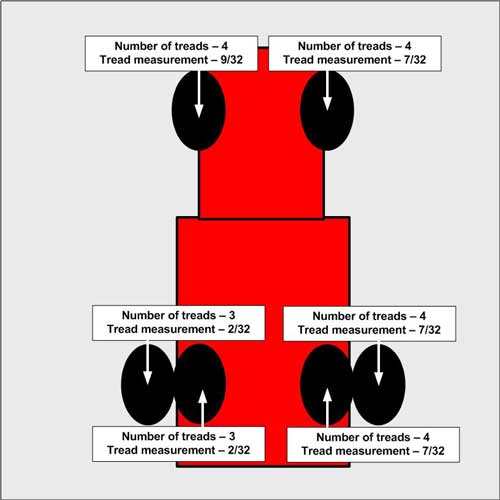
Diagram 2. Diagram depicts tire tread information.
NFPA 1071, Standard for Emergency Vehicle Technician Professional Qualifications, applies to personnel who are engaged in the inspection, diagnosis, maintenance, repair, and testing of emergency response vehicles.11 This standard identifies and defines the minimum job performance requirements for a person to be considered qualified as an emergency vehicle technician (EVT) and outlines requirements for qualification. The standard defines methods for evaluating emergency vehicle technician qualifications which include schooling, training, practical experience, and existing certification programs. Programs such as Automotive Service Excellence (ASE),12 the Emergency Vehicle Technicians Certification Commission (EVT),13 or a technician certification program recognized by a federal or state agency, or equivalent, can be utilized to help determine the requisite knowledge and skills of a maintenance technician candidate.
NFPA 1071, Annex A, states that there are certain components on emergency response vehicles that are not considered unique and it is not the intent of the standard to restrict departments from using persons they feel are qualified to perform inspection, diagnosis, maintenance, repair, and testing of those components. However, an emergency response vehicle is a complex piece of machinery and there are many components that are highly integrated. Because of this complexity, this standard requires that a person qualified as an emergency vehicle technician possess minimum skills and knowledge to inspect, diagnose, and perform repairs.11
At the time of the incident, the department had contracted with an outside apparatus maintenance / inspection company that provided regularly scheduled apparatus checks. It was not possible to ascertain if all of the mechanics who serviced the fire apparatus were certified emergency response vehicle technicians as recommended and defined by NFPA 1071.11
Recommendation #4: Fire departments should provide initial and refresher training to all drivers on each vehicle they may be called upon to operate.
Discussion: Responding to and returning from emergency incidents is second only to heart attacks as the cause of fire fighter line-of-duty deaths. Under all circumstances, the fire apparatus driver/operator must exercise care for the safety of others and must maintain complete control of the vehicle. Avoiding conditions that lead to skidding is as important as knowing how to correct skids once they occur. Operator training should address this issue and include the most common causes of skids which are:
- Driving too fast for conditions
- Failing to properly appreciate weight shifts of heavy apparatus
- Failing to anticipate obstacles (these range from other vehicles to animals)
- Improper use of auxiliary braking devices
- Improper maintenance of tire air pressure and adequate tread depth
A flat, dry, paved road provides the optimal stopping surface. The ability of a driver/operator to stop the apparatus is negatively affected by steep, wet, snowy, icy, or unpaved roads. Driver/operators must compensate for these conditions by reducing their speeds by an appropriate amount to match the conditions.
Fire departments should ensure that fire department driver/operators are trained in techniques for maintaining control of their vehicle at all times. Driver training SOPs should be developed, and training should be conducted, in accordance with NFPA 1451, Standard for a Fire Service Vehicle Operations Training Program14 and NFPA 1002, Fire Apparatus Driver/Operator Professional Qualifications, 15 as well as, NFPA 1500 5.3.3 and 5.2.3 Standard on Fire Department Occupational Safety and Health Program.2 These standards state that departments should establish and maintain a driver training education program and each member should be provided driver training not less than twice a year. All vehicle/apparatus drivers should receive training specific to each vehicle they may be called upon to operate and this training should address vehicle characteristics, capabilities and limitations. Each driver should operate the vehicle and perform all tasks that the driver/operator of that specific vehicle may be expected to encounter. The training should be developed to ensure that driver operators are skilled in operating the vehicle safely and that they understand how to comply with all applicable highway laws and regulations.9
SOP’s for driving fire department vehicles during nonemergency travel and emergency response should include, but not be limited to, the principles of skid avoidance and the effects of liquid surge, load factors, general steering reactions, and speed on vehicle control. Common causes for loss of control are driving too fast for road conditions, failing to properly react to weight shifts of heavy emergency vehicles/apparatus, driver distraction, and failing to anticipate obstacles.
In this incident, records indicate that in 2009 the Victim had completed a 12-hour driver-operator course, and in 2010 he completed a 3-hour course on operating emergency vehicles. Fire department members receive monthly fire service training that is conducted by department personnel in-house, or through the fire and emergency training institute that is affiliated with a state university. The degree of practical hands-on training could not be determined.
Recommendation #5: Fire departments should ensure that seatbelts are properly worn at all times by drivers and occupants of all department vehicles.
Discussion: Fire departments should develop and enforce SOPs on the use of seatbelts. NFPA 1500, Standard on Fire Department Occupational Safety and Health Program states that all persons riding in fire apparatus shall be seated and belted securely by seat belts in approved riding positions at any time the vehicle is in motion. The standard further states that seat belts shall not be released or loosened for any purpose while the vehicle is in motion.2 Numerous nationally recognized fire service entities have guidance available on implementing a seat belt policy. The International Association of Fire Chiefs (IAFC), Guide to IAFC Model Policies and Procedures for Emergency Vehicle Safety, states that “The driver shall not begin to move the vehicle until all passengers are seated and properly secured. All passengers shall remain seated and secured as long as the vehicle is in motion.3
Vehicle crashes are historically the second leading cause of fire fighter line of duty deaths. Seat belts are not only important for protecting occupants in the event of a crash, but they may be useful in helping to avoid crashes. The U.S. Fire Administration’s Safe Operation of Fire Tankers states “Some crash reconstruction specialists have speculated that particular incidents may have occurred after the unrestrained driver of a truck was bounced out of an effective driving position following the initial contact with a bump in the road or another object.”16 In the same publication, the USFA also cites a Department of Transportation study of seat belt use which revealed the following statistics: (1) 75 percent of the people ejected from vehicles suffer fatal injuries; (2) 80 percent of fatalities in rollover incidents involve occupants being ejected from the vehicle; and (3) in a rollover incident, occupants are 22 times more likely to be thrown from the vehicle if they are not wearing their seat belts.16
To increase the use of seat belts by fire fighters, the National Fire Service Seat Belt Pledge campaign was created.17 The United States Fire Administration, National Fallen Fire Fighters Foundation, National Institute for Occupational Safety and Health, International Association of Fire Chiefs, National Volunteer Fire Council, and the National Fire Protection Association support the campaign as a method of raising awareness of the importance of mandatory use of seat belts by all fire fighters.18 Fire fighters who take the pledge, and fire departments who achieve 100% pledge participation, show their individual and organizational commitment to fire fighter safety.19
When interviewed about this incident, witnesses’ recollections of the Victim’s seat belt use and location in the cab immediately following the crash conflicted on this issue. According to the police report, the use of a seat belt is unknown.
Recommendation # 6: Fire departments should ensure that all vehicle modifications are completed by a qualified source and are designed and installed within the manufacturer’s specifications and NFPA guidelines.
Discussion: The vehicle involved in this incident was a 1998 Ford F150 pickup truck that had been retrofitted to accommodate a slip-on-unit. NFPA 1912 Standard for Fire Apparatus Refurbishing20 specifies the minimum requirements for the refurbishing of automotive fire apparatus utilized for fire fighting and rescue operations, whether the refurbishing is done at the fire department or municipal maintenance facilities, or at the facilities of private contractors or apparatus manufacturers.
It is important to understand how retrofitting vehicles can change the vehicle’s weight and center of gravity. The addition of extra equipment such as water tanks, pumps, hoses and tools add extra weight which can raise the vehicle’s center of gravity higher than when originally manufactured. A low center of gravity contributes to improved vehicle stability. Fire departments should be aware of resources such as the Roscommon Equipment Center, a cooperative program between the National Association of State Foresters and the Michigan Department of Natural Resources.21 Roscommon Equipment Center develops guidelines for local, state, and federal fire agencies to safety convert vehicles to specific types of fire apparatus. Fire departments should consider weighing their fully-loaded vehicles and keeping an inventory of the various equipment and tools maintained on the vehicle to help ensure that vehicles are operated within their rated capacities.
There is no evidence that the retrofitted slip on unit contributed to the incident. However, it is important to continually assess any additions or modifications to fire service vehicles to ensure safe operation is not being compromised.
Recommendation #7: Fire departments should be aware of programs that provide assistance in obtaining alternative funding, such as grant funding, to replace or purchase fire apparatus and equipment.
Discussion: While it is important that fire departments seek constant improvements and upgrades to their fire apparatus and equipment, some departments may not have the resources or programs to replace or upgrade their apparatus and equipment as often as they should. Alternative funding sources, such as federal grants, are available to purchase fire apparatus and equipment. Additionally, there are organizations that can assist fire departments in researching, requesting, and writing grant applications.
Federal Emergency Management Agency (FEMA), Assistance to Firefighters Grant (AFG) Programexternal icon
http://www.fema.gov/welcome-assistance-firefighters-grant-program
The primary goal of the Assistance to Fire Fighters Grant (AFG) Program is to provide critically needed resources such as emergency vehicles and apparatus, equipment, protective gear, training for responders, and other needs to help fire departments protect the public and emergency workers from fire and related hazards. FEMA grants are awarded to fire departments to enhance their ability to protect the public and fire service personnel from fire and related hazards. The Grant Programs Directorate of FEMA administers the grants in cooperation with the United States Fire Administration. This Web site offers resources to help fire departments prepare and submit grant requests.
National Volunteer Fire Council (NVFC), Grants & Fundingexternal icon
http://www.nvfc.org/hot-topics/grants-funding (Link updated 4/9/2013)
The NVFC provides an online resource center to assist departments applying for various types of fire grants, including narratives from successful past grant applications and a listing of federal grant and funding opportunities.
FireGrantsHelp.comexternal icon
www.firegrantshelp.com
A nongovernmental group, FireGrantsHelp’s mission is to provide firefighters and departments with a comprehensive resource for grant information and assistance. FireGrantsHelp.com provides an extensive database of information on federal, state, local, and corporate grant opportunities for first responders.
Additional resources related to staffing and training include:
FEMA, Staffing for Adequate Fire and Emergency Response (SAFER) Grantsexternal icon
http://www.fema.gov/welcome-assistance-firefighters-grant-program
SAFER grants provide funding directly to fire departments and volunteer firefighter interest organizations to help them increase the number of trained, front-line fire fighters in their communities and to enhance the local fire departments’ abilities to comply with staffing, response, and operational standards established by NFPA and the Occupational Safety and Health Administration.
National Fire Protection Association (NFPA), Safer Act Grantexternal icon
www.nfpa.org/codes-and-standards/standards-development-process/safer-act-grant (Link Updated 8/13/2013)
NFPA provides excerpts from NFPA 1710 and NFPA 1720 and other online resources to assist fire departments with the grant application process.
Federal Excess Personal Property Programexternal icon
www.fs.fed.us/fire/partners/fepp
The Federal Excess Personal Property Program is administered by the US Forest Service. This program refers to Forest Service-owned property that is on loan to State Foresters for the purpose of wildland and rural fire fighting. Most of the property originally belonged to the US Department of Defense. Once acquired by the Forest Service, property is loaned to State Coordinators for fire fighting purposes. State Foresters may place property with local fire departments to improve local fire programs.
Department of Defense Firefighter Programexternal icon
http://www.fs.fed.us/fire/partners/fepp/DODprogram/index.html
In cooperation with the US Forest Service, excess Department of Defense equipment is made available for wildland and rural fire fighting purposes through the Federal Excess Personal Property Program.
Rural & Volunteer Fire Assistanceexternal icon
http://www.fs.fed.us/fire/partners/vfa/
The US Forest Service, Volunteer Fire Assistance Program (VFA), formerly known as the Rural Community Fire Protection Program (RCFPP) can provide Federal financial, technical, and other assistance to State Foresters and other appropriate officials to organize, train, and equip fire departments in rural areas and rural communities to suppress fires. A rural community is defined as having 10,000 or less population.
References
- Weather underground [2011]. History Saturday, September 3, 2011: external iconhttp://www.wunderground.com/history/airport/KRSN/2011/9/3/DailyHistory.html?req_city=NA&req_state=NA&req_statename=NA Date accessed: August 2012.
- NFPA [2007]. NFPA 1500 Standard on fire department occupational safety and health program. 2007 ed. Quincy, MA: National Fire Protection Association.
- International Association of Fire Chiefs. Guide to Model Policies and Procedures for Emergency Vehicle Safety. pdf iconexternal iconhttp://www.iafc.org/files/1SAFEhealthSHS/VehclSafety_IAFCpolAndProceds.pdf Date accessed: October 2012. (Link updated 10/28/2013)
- National Volunteer Fire Council (NVFC). Emergency Vehicle Safe Operations for Volunteer and Small Combination Emergency Service Organizations.pdf iconexternal icon http://www.nvfc.org/files/documents/EVSO_2009.pdf Date accessed August 2012.
- USFA/FEMA [2004]. Emergency Vehicle Safety Initiative.pdf iconexternal icon Emmitsburg, MD: U.S. Fire Administration, Publication No FA-272 http://www.usfa.fema.gov/downloads/pdf/publications/fa-272.pdf Date accessed: August 2012.
- ERSI Emergency Responder Safety Institute. Training downloads.external icon http://www.respondersafety.com/DownloadCategories/Training.aspx Date accessed: September 2012 (Link updated 4/9/2013)
- VFIS Emergency responder education training and consulting.external icon http://www.vfis.com/emergency-responder-education-training-consulting.htm Date accessed: October 2012.
- NFPA [2010]. NFPA 1250 Recommended practice in emergency service organization risk management. 2010 ed. Quincy, MA: National Fire Protection Association.
- NIOSH [2001]. NIOSH Hazard ID: Fire fighter deaths from tanker truck rollovers. Cincinnati, OH: U.S. Department of Health and Human Services, Public Health Service, Centers for Disease Control and Prevention, National Institute for Occupational Safety and Health, DHHS (NIOSH) Publication No. 2002-111. https://www.cdc.gov/niosh/docs/2002-111/ Date accessed: August 2012.
- NFPA [2007]. NFPA 1911, Standard for the inspection, maintenance, testing, and retirement of in-service automotive fire apparatus. 2007 ed. Quincy, MA: National Fire Protection Association.
- NFPA [2011] NFPA 1071, Standard for emergency vehicle technician professional qualifications. 2011 ed. Quincy, MA: National Fire Protection Association.
- Automotive Service Excellence.external icon (ASE) https://www.ase.com/Home.aspx Date accessed: September 2012. (Link Updated 4/9/2013)
- Emergency Vehicle Technicians Certification Commission (EVTCC)external icon http://www.evtcc.org Date accessed: September 2012
- [2007]. NFPA 1451, Standard for a fire service vehicle operations training program. 2007 ed. Quincy, MA: National Fire Protection Association.
- NFPA [2009]. NFPA 1002 Standard for fire apparatus driver/operator professional qualifications. 2009 ed. Quincy, MA: National Fire Protection Association.
- USFA/FEMA [2003]. Safe operation of fire tankers.pdf iconexternal icon Emmitsburg, MD: U.S. Fire Administration, Publication No. FA 248. http://www.usfa.fema.gov/downloads/pdf/publications/fa-248.pdf Date accessed: October 2012.
- International First Responder Seat Belt Pledgeexternal icon [2011]. http://everyonegoeshome.com/seatbelts/about/ Date Accessed: October 2012.
- US Fire Administration [2009]. NIOSH supports seat belt use by fire fighters.external icon Press release http://www.usfa.fema.gov/media/press/2008releases/111808.shtm Date accessed: August 2012. (Link Updated 1/29/2013)
- Cade, Gregory B. [2008]. “Seatbelts, Enough is Enough, Buckle Up.”pdf iconexternal icon http://www.everyonegoeshome.com/wp-content/uploads/sites/2/2015/02/august2008.pdf Date accessed: October 2012. (Link Updated 5/13/2015)
- NFPA [2011]. NFPA 1912 Standard for fire apparatus refurbishing. 2011 ed. Quincy, MA: National Fire Protection Association.
- Roscommon Equipment Center, Project #61, December 1999, Slip-on water tank unitspdf iconexternal icon, National Association of State Foresters in cooperation with Michigan’s Forest Fire Experiment Station. http://www.roscommonequipmentcenter.com/Project%2061_Slip%20On%20Water%20Tank%20Units.pdf Date accessed: August 2012. (Link Updated 1/14/2014)
Investigator Information
This incident was investigated by Virginia Lutz, Safety and Occupational Health Specialist, with the Fire Fighter Fatality Investigation and Prevention Program, Surveillance and Field Investigations Branch, Division of Safety Research, NIOSH located in Morgantown, WV. An expert technical review was provided by Chief Rich Marinucci. A technical review was also provided by the National Fire Protection Association, Public Fire Protection Division.
Additional Information
The NIOSH Fire Fighter Fatality Investigation and Prevention Program would like to acknowledge the Jackson Parish Sheriff’s Department and the Louisiana State Police for their assistance with this investigation.
Disclaimer
Mention of any company or product does not constitute endorsement by the National Institute for Occupational Safety and Health (NIOSH). In addition, citations to Web sites external to NIOSH do not constitute NIOSH endorsement of the sponsoring organizations or their programs or products. Furthermore, NIOSH is not responsible for the content of these Web sites.
The National Institute for Occupational Safety and Health (NIOSH), an institute within the Centers for Disease Control and Prevention (CDC), is the federal agency responsible for conducting research and making recommendations for the prevention of work-related injury and illness. In 1998, Congress appropriated funds to NIOSH to conduct a fire fighter initiative that resulted in the NIOSH “Fire Fighter Fatality Investigation and Prevention Program” which examines line-of-duty-deaths or on duty deaths of fire fighters to assist fire departments, fire fighters, the fire service and others to prevent similar fire fighter deaths in the future. The agency does not enforce compliance with State or Federal occupational safety and health standards and does not determine fault or assign blame. Participation of fire departments and individuals in NIOSH investigations is voluntary. Under its program, NIOSH investigators interview persons with knowledge of the incident who agree to be interviewed and review available records to develop a description of the conditions and circumstances leading to the death(s). Interviewees are not asked to sign sworn statements and interviews are not recorded. The agency’s reports do not name the victim, the fire department or those interviewed. The NIOSH report’s summary of the conditions and circumstances surrounding the fatality is intended to provide context to the agency’s recommendations and is not intended to be definitive for purposes of determining any claim.
or call toll free 1-800-CDC-INFO (1-800-232-4636).
